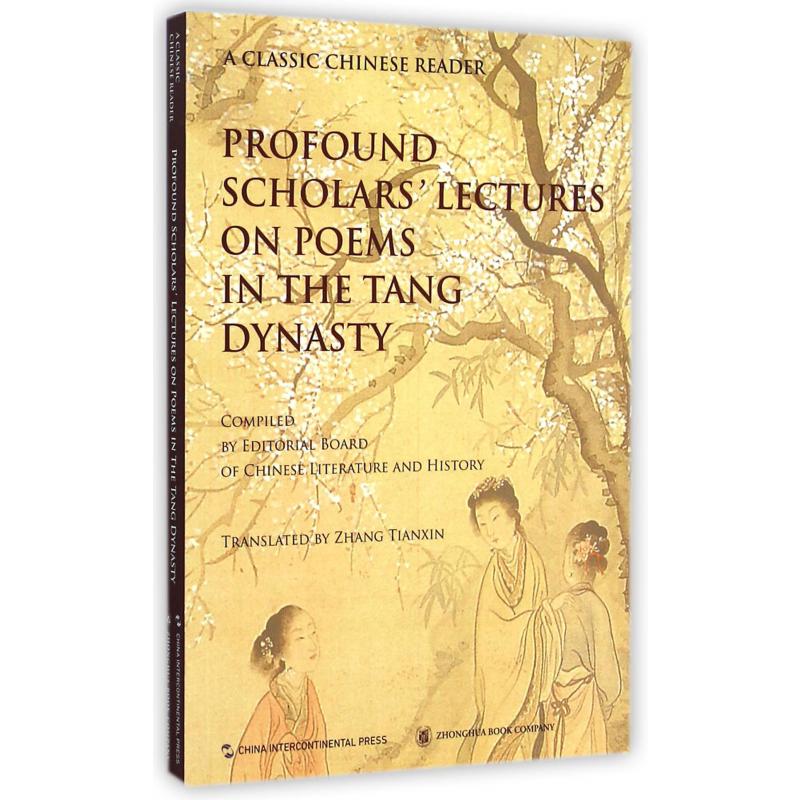
出版社: 五洲传播
原售价: 109.00
折扣价: 62.13
折扣购买: 名家讲唐诗(英文版)
ISBN: 9787508529981

《文史知识》1981年创刊,坚持“大专家写小文章”的办刊宗旨,作者队伍荟萃了全国一流文史学者,从不同角度、以多样手法,深入浅出地介绍、评述优秀传统文化。除期刊外,多年来,编辑部也出版了一系列文史知识丛书,力图多方位向广大读者介绍中国的传统文化瑰宝。
Sweet Laurel Blooms in the Poem Entitled “The Dale of Singing Birds” Guo Xiliang When I browsed through the book entitled “Gems of Classical Chinese Poetry” which was published by the Zhonghua Book Company in 1999, I found by accident an explanation for the Chinese character “闲” (pronounced as xian in Chinese phonetic alphabet) in the first line of Wang Wei’s five-character quatrain “The Dale of Singing Birds”. Of all the phrases in the poem, only this character was chosen and briefly annotated by the editors and scholars to make the whole piece easier to understand. According to the note right there in the book, the character “闲” means “quiet”. Presented by the full-length series entitled “Chinese Ancient Poetry and Prose Textbooks”, the explanation for the line goes that “sweet laurel blooms fall gently in large numbers at the quiet moment”. My further probes into the annotations show that the explanation of this kind is nothing but the simple repetition of other people’s viewpoints. As early as 1970s, the Institute of Chinese Literature under the Chinese Academy of Social Sciences compiled “The Selected Tang Poems” which was published by the People’s Literature Publishing House in 1978. In this book, the annotation of sweet laurel blooms reads:”Also known as muxi in Chinese phonetic alphabet, they can be divided into such different kinds as the so-called ‘spring blossoms’, ‘autumn blossoms’, and ‘four-season blossoms’. What is mentioned right here is the ones which are in full bloom in the spring. Another explanation for them refers to the ones which are in full bloom in the winter and wither in the late spring. The Chinese character “闲” means “quiet”. The first line can read in an extended sense: At the extremely quiet locations which are off the beaten track, unenjoyed sweet laurel blooms fall silently.” However, Ge Jie and Cang Yangqing put forward another different viewpoint while editing and elaborately annotating the book entitled “Three Hundred Quatrains” which was published by the Shanghai Chinese Classics Publishing House in 1980. In accordance with their annotation, the sweet laurel blooms refer to “moonlight”. Ancient Chinese legends show that a laurel tree was planted in the moon in remote antiquity. As a result, the “laurel tree”, in their opinion, is often used to denote the moon in Chinese classics. Accordingly, the phrase “桂花落” means “bright light that the moon throws down sprinkles the ground all over”. I personally think their annotation in “Three Hundred Quatrains” is correct. However, an article “Sweet Laurel Blooms Have Nothing To Do With Moonlight” authored by Liu Pu draws a completely different conclusion. According to the article published in the first issue of the magazine “Literary Review” in 1983, the annotation about the sweet laurel blooms in “The Selected Tang Poems” is correct while that in “Three Hundred Quatrains” teems with blunders. With the widespread circulation of the article which seemed to reach a final conclusion on this matter, “Gems of Classical Chinese Poetry”, and other popular writings, I think it is necessary for me to tell numerous readers what happened so that they will not incorrectly relay erroneous messages any longer. Now Let us read the whole piece above all: Sweet laurel blooms fall unenjoyed; Vague hills dissolve into night void. The moonrise startles birds to sing; Their twitters fill the dale with spring.


